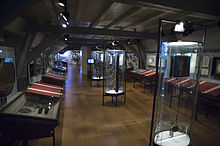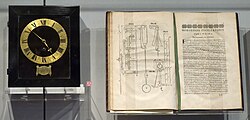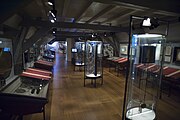User:Jelle Beijer/Museum Boerhaave
 | |
| Established | 1991 [1] |
|---|---|
| Location | Lange Sint Agnietenstraat 10 Leiden, Netherlands |
| Type | History of science museum |
| Collection size | 25 rooms, 211 showcases, approx. 3000 objects [2] |
| Visitors | 42,187 (2008) [3] |
| Director | Dirk van Delft |
| Curator | Hans Hooijmaijers |
| Public transit access | Central Station Leiden (10 minutes walk, 900 meter) |
| Website | www.museumboerhaave.nl |
Temporary project notes: for now, for demo purposes only, some images have been included three times: inline, as gallery and stacked at the right. The current images reside on Commons Some had been uploaded by the photographer first to Flickr with Creative commons Attribution Share Alike license.
Also compare current live revision (stub level!), started July 2005, last update September 2009, ~ 30 edits
Museum Boerhaave is a museum of the history of science and the history of medicine, located in central Leiden, the Netherlands. The museum is named after Herman Boerhaave, a famous Dutch physician and botanist.
The museum building was originally a convent. It includes a reconstructed traditional anatomical theatre. It also has many galleries that include the apparatus with which Heike Kamerlingh Onnes first liquefied helium (in Leiden), the electromagnet equipment used by Wander Johannes de Haas (a Leiden physicist) for his low-temperature research, and an example of the Leiden jar, among many other objects in the extensive collection.
History[edit]
Boerhaave Museum’s history began in 1907, when a Historical Exhibition of Natural Science and Medicine was held in the Academy Building Academiegebouw (Leiden) of Leiden University. The many objects in the exhibition came from all the learned corners of the country. It was a great success and there were immediately calls to set up a permanent science history exhibit. [4] In 1928 a foundation was initiated by physicist Claude August Crommelin, who worked at Leiden university, for a museum for the history of natural sciences. The aim of the museum was described in the preliminary statutes of the foundation: "the collection of instruments, tools, slides and specimens, documents and other objects, which are important for the history of the natural sciences; to look after these objects, describe them and keep them in a museum which is to be located in Leiden". The sciences to be represented included: Astronomy, Physics, Chemistry, Botany, Zoology, Pharmacy, all medical sciences - including Physiology, Anatomy etcetera, and Mathematics.
In 1931 the museum opened as "The Dutch Historical Museum of the Natural Sciences" (Het Nederlandsch Historisch Natuurwetenschappelijk Museum). To the view of Crommelin, the museum was to become a national museum: the 's Gravesande-Musschenbroek collection would form the starting point, to which collections form other institutes were to be added.
In 1947 the museum, which was in fact a private foundation, became formally a national museum. It was renamed to "The Dutch National Museum for the History of the Natural Sciences" (Rijksmuseum voor de Geschiedenis van Natuurwetenschappen). An advisory board was installed in which members of Dutch universities would take seat. It underlined the ambition to become a national museum, not a museum solely connected to the Leiden University. The plan was to merge collections of all scientific institutes in one museum, but this did not truely succeed.
From 1967 on it became clear that a new location was needed to properly display the collection: the former nunnery of St Caecilia. With the prospect of a new location the name of the Museum was changed to "Museum Boerhaave". However, it took more than twenty years before the museum finally moved.[5]
Location[edit]
Before moving in 1991, the museum was located in the former Boerhaave Laboratory at the Steenstraat 1, Leiden, a building which belonged to the Leiden Academic Hospital (Leiden Academisch Hospital), now part of LUMC, Leiden University Medical Center. This location of the museum now houses the National Museum of Ethnology.
To create better housing the former nunnery of Saint Cecilia was bought by de Government Buildings Agency (Rijksgebouwendienst). This historic building has had various functions over time. Once a nunnery of St Caecilia, the building dates from the early 15th century. The building had become municipal property after the Protestant Reformation and shortly before 1600 was converted into a pest house and lunatic asylum. The Leiden Academic hospital was founded in this location between 1636 and 1639 [6]. After extensive restoration and expansion, the building is in use as a museum since 1991.[7]
Collection[edit]



Project note: high res version of the picture in the museum's own collection would be preferable.

Note: section development in progress
The Boerhaave Museum is running a project to document all approx. 3000 objects in its collection online, with pictures and descriptions for every single object. In April 2010 the site featured over 1750 objects, ordered by room and showcase. This overview is in large part based on the museum's online documentation.
The museum has 25 rooms, which are thematically organised, as follows. [8]
- 0 Museum Foyer [9]
Gapers (wooden heads miming the swallowing of pills) and other shop signs for pharmacies and druggists. Also a 'dictionary of health': a tall book-shaped wooden chest (1660) filled with simples (basic substances used in medicine).
- 1 The Leiden Anatomical Theater [10]
 |

|
The room shows a reconstruction (1988) of the Theatrum Anatomicum (anatomical theatre) (built 1596). A richly decorated instrument chest (1670) which belonged to the Leiden surgeon's guild. A small collection of objects (largely Egyptian antiquities) that survived from the now gone Leiden Theatrum (one of the oldest museums of Europe [citation needed]) are shown as well. On the wall three paintings: one depicting the magistrates of the Catharina and Caecilia Hospitals (the latter now houses the museum), a second showing a Prussian peasant from whom a 10 inch sword, swallowed in a drinking bout, has surgically been removed, a third showing renowned surgeon and designer of medical instruments Cornelis Solingen (1680). One of Solingen's inventions (part of the collection) was a screw to unindent a soldiers skull who had been hit by a bullet. Often in those days bullets did not fully penetrate a skull, merely deformed it.[11]
- 2 Drawn from life [12]
Four large allegoric paintings (± 1610) show in stages how the appreciation of a patient for his physician declines, from being a true savior when the illness is at its height, towards being a devil when the bill has been delivered. Three solid figures of Saints Cosmas and Damian, patrons of doctors and pharmacists. Six anatomical books and drawings (1520-1570) and six books on herbs (1480-1590) testify how in the Renaissance there was an urge to study life diligently and not take traditional beliefs for granted. A large collection of baked and painted apothecary jars (1550-1650) and (often ornamented) cast-iron and bronze mortars (1350-1700).
- 3 The Golden Age [13]
 |
 |
- 4 The University of Leiden. Boerhaave and ‘s Gravensande [14]
- 5 The University of Leiden. Linnaeus and Van Musschenbroek [15]
Carl Linnaeus published his famous Systema Naturae in 1735, during his 3 year stay in Holland, in which he also earned a degree in medicine, and closely worked together with Boerhaave. At display are paintings of Linnaeus and Boerhaave. Also 18th century models and scientific measuring instruments: models that demonstrate basic physics principles, and instruments: several antique thermometers, a barometer, a theodolite and several pyrometers. Also two antique globes (one showing the heavens, one earth) and two mirror telescopes. The room is conamed after the brothers van Mussenbroeck: Pieter a professor, credited with the invention of the first capacitor in 1746: the Leyden jar, and Jan a famous instrument maker, who shipped his hand crafted precision thermometers all over Europe.
- 6 The wonders of nature [16]
Over 30 antique microscopes are shown, most from the 18th century, in a large variety, with different solutions for lighting the subject and minimization of lens defects (e.g. chromatic aberration): simple, compound and reflecting microscopes, so called English microscopes (renowned for their quality), solar microscopes (which project their image on a wall, using sunlight only). Several wooden cabinets with microscopic slides are testimony of the craftmanship than went into collections of ready made samples, which at the time were highly fashionable among well-to-do citizens who took an interest in scientific developments.
- 7 Collection: The Albinus Brothers [17]
The room is dedicated to famous 18th-century anatomist Bernhard Siegfried Albinus and his brother and successor Frederik Bernhard Albinus, showing a few of the over 750 wet and dry anatomical samples that Bernhard Siegfried collected, and a wide variety of medical instruments (most 1670-1700) collected by his brother: several amputation saws and knifes, cauterizing irons, a wide variety of forceps and clamps, spatula's, an elevator, a bullet extractor and brace, several (drill) crowns, two drills, a lenticular, several elevatoriums, a chuck key, a coach screw, a retractor, lithotomy scoops, a Phimosis knife, gorgerets, a catheter, a bistoury cache, a combined syringotome and seton needle, a wound retractor, lithotomy directors, probes, a tobacco enema
- 8 Collection: Sebaldus Justinus Brugmans [18]
Sebald Justinus Brugmans was a Dutch botanist, physician and professor of natural sciences. As an army physician he became notable for his battle against unsanitary conditions, and spread of contagious diseases. The room shows a large collection of fish skins ('the protected body'), human skulls (some affected by accident or disease), animal skulls (mainly birds) and a variety of other anatomic samples, including some foetusses in a jar.
- 9 Collection: Nature in drawers and cabinets [19]
- 10 Hendrik Bosch’s collection of medicine, Butterfly cabinet [20]
- 11 Collection: Theodoor Gerard van Lidth de Jeude [21]
Shown are a collection of 19th century animal organ specimens (protected against decay with wax and varnish) which had been prepared for research (e.g. comparative anatomy), and educational purposes (e.g. veterinarian school). Also shown are anatomical drawings from that same period. Many specimens and drawings are from large mammals, cattle but even more large mammals of non European origin.
- 12 Collection: Repositories of the animal kingdom [22]
- 13 Collection: Petrus Koning [23]
Anatomical wax models by Petrus Koning (1787-1834), anatomical gouaches
- 14 Temporary exhibition space
- 15 Temporary exhibition space
- 16 Electricity and light [24]
- 17 Zander Devices [25]
Devices for physiotherapy using the method of Swedish physician Gustav Zander, developed ca. 1865. These devices featured on two world exhibitions. Their succes let to 120 Sander institutes world-wide.
- 18 Specialisation in medicine [26]
- 19 The Anatomical world of Dr Auzoux [27]
French doctor Louis Auzoux (1797 – 1870) pioneered the use of papier-mâché for highly detailed and colored anatomical models, with detachable parts, which allowed mass production for educational purposes. A selection of the many models on display: many human body parts, for example a box set with a model of female sexual organs plus almost 20 embryonic stages, models of the womb for every month of pregnancy. For purposes of comparative anatomy: models of brain or nervous system of diverse animals, models of blood circulation in diverse animals (e.g. a turtle, a crocodile), models of stomach or alimentary canal (e.g. octopus, honey bee).
- 20 Chemistry: The Netherlands First Nobel Prize [28]
- 21 Physics: Factories of Science [29]
- 22 Medicine: man as machine [30]
Pieces at display include: a gigantic microtome, the first heart-lung machine (prototype) by inventor Jacob Jongbloed (1948), the first kidney dialysis machine by inventor Willem Johan Kolff, X-ray equipment, an iron lung, galvanometer tools, a bow and arrow used to draw ultra thin quartz fibres (by shooting away a droplet of molten quartz), the original golden Nobel Prize medal from Willem Einthoven (for developing the first practical electrocardiogram in 1903)
- 23 Astronomy: Celestial Accounting [31]
- 24 Microscopy: new ways [32]
The room houses two electron microscopes (1947-1950) and related equipment (gold vaporiser, lens, object holders, a cooler, a goniometer), a collection of compound and specimen microscopes (some binocular) (1840-1870) plus accompanying microscope lamps and a tool box, a binocular polarisation microscope (1850), several microtomes (a.o. a cryomicrotome) and ultramicrotomes, a phase contrast microscope, a fluorescence microscope (plus several epi-illuminators, to exploit the difference between emitted and reflected light frequencies that some substances display), compound microscope with transformer in camera installation, a photomicroscope (photo camera with inverted microscope), a boxed collection of microscopic specimens (1870).
Library[edit]
Note: see for inspiration e.g. American_Museum_of_Natural_History
Research[edit]
Note: see for inspiration e.g. American_Museum_of_Natural_History
Education Projects[edit]
Location[edit]
Note: see for inspiration e.g. American_Museum_of_Natural_History
Images[edit]
 |
 |
 |
See also[edit]
References[edit]
- ^
"Collection History". www.museumboerhaave.nl. Museum Boerhaave. Retrieved 2010-04-29.
{{cite web}}: External link in|work= - ^
"Boerhaave Museum Top Collection: all rooms". [1]. Museum Boerhaave. Retrieved 2010-04-29.
{{cite web}}: External link in|work= - ^
"Jaarverslag 2008 (Year report 2008)" (PDF). [2]. Museum Boerhaave. Retrieved 2010-04-29.
{{cite web}}: External link in|work= - ^
"Boerhaave and his time". [3]. Museum Boerhaave. Retrieved 2010-04-29.
{{cite web}}: External link in|work= - ^ "75 jaar Museum Boerhaave - Mededeling 316", pp. 5-19, Museum Boerhaave, Leiden, 2006, ISBN 9062921390 Parameter error in {{ISBN}}: checksum.
- ^
"Boerhaave and his time". [4]. Museum Boerhaave. Retrieved 2010-04-29.
{{cite web}}: External link in|work= - ^
[hhttp://www.museumboerhaave.nl/museum-/virtueel_bezoek/virtueel_gebouw_e.html "Boerhaave and his time"]. [5]. Museum Boerhaave. Retrieved 2010-04-29.
{{cite web}}: External link in|work= - ^ "Boerhaave Museum Top Collection: all rooms". [6]. Museum Boerhaave. Retrieved 2010-04-29.
{{cite web}}: External link in|work= - ^
"Boerhaave room 0". [7]. Museum Boerhaave. Retrieved 2010-04-29.
{{cite web}}: External link in|work= - ^
"Boerhaave room 1". [8]. Museum Boerhaave. Retrieved 2010-04-29.
{{cite web}}: External link in|work= - ^
"Cornelis Solingen". [9]. Museum Boerhaave. Retrieved 2010-05-03.
{{cite web}}: External link in|work= - ^
"Boerhaave room 2". [10]. Museum Boerhaave. Retrieved 2010-04-29.
{{cite web}}: External link in|work= - ^
"Boerhaave room 3". [11]. Museum Boerhaave. Retrieved 2010-04-29.
{{cite web}}: External link in|work= - ^
"Boerhaave room 4". [12]. Museum Boerhaave. Retrieved 2010-04-29.
{{cite web}}: External link in|work= - ^
"Boerhaave room 5". [13]. Museum Boerhaave. Retrieved 2010-04-29.
{{cite web}}: External link in|work= - ^
"Boerhaave room 6". [14]. Museum Boerhaave. Retrieved 2010-04-29.
{{cite web}}: External link in|work= - ^
"Boerhaave room 7". [15]. Museum Boerhaave. Retrieved 2010-04-29.
{{cite web}}: External link in|work= - ^
"Boerhaave room 8". [16]. Museum Boerhaave. Retrieved 2010-04-29.
{{cite web}}: External link in|work= - ^
"Boerhaave room 9". [17]. Museum Boerhaave. Retrieved 2010-04-29.
{{cite web}}: External link in|work= - ^
"Boerhaave room 10". [18]. Museum Boerhaave. Retrieved 2010-04-29.
{{cite web}}: External link in|work= - ^
"Boerhaave room 11". [19]. Museum Boerhaave. Retrieved 2010-04-29.
{{cite web}}: External link in|work= - ^
"Boerhaave room 12". [20]. Museum Boerhaave. Retrieved 2010-04-29.
{{cite web}}: External link in|work= - ^
"Boerhaave room 13". [21]. Museum Boerhaave. Retrieved 2010-04-29.
{{cite web}}: External link in|work= - ^
"Boerhaave room 16". [22]. Museum Boerhaave. Retrieved 2010-04-29.
{{cite web}}: External link in|work= - ^
"Boerhaave room 17". [23]. Museum Boerhaave. Retrieved 2010-04-29.
{{cite web}}: External link in|work= - ^
"Boerhaave room 18". [24]. Museum Boerhaave. Retrieved 2010-04-29.
{{cite web}}: External link in|work= - ^
"Boerhaave room 19". [25]. Museum Boerhaave. Retrieved 2010-04-29.
{{cite web}}: External link in|work= - ^
"Boerhaave room 20". [26]. Museum Boerhaave. Retrieved 2010-04-29.
{{cite web}}: External link in|work= - ^
"Boerhaave room 21". [27]. Museum Boerhaave. Retrieved 2010-04-29.
{{cite web}}: External link in|work= - ^
"Boerhaave room 22". [28]. Museum Boerhaave. Retrieved 2010-04-29.
{{cite web}}: External link in|work= - ^
"Boerhaave room 23". [29]. Museum Boerhaave. Retrieved 2010-04-29.
{{cite web}}: External link in|work= - ^
"Boerhaave room 24". [30]. Museum Boerhaave. Retrieved 2010-04-29.
{{cite web}}: External link in|work= - ^ http://www.museumboerhaave.nl/AAcollection/english/M03V20_V09853.html]]
- ^ http://www.museumboerhaave.nl/AAcollection/english/M03V20_g13604.html
External links[edit]
- Museum Boerhaave website (in English)
